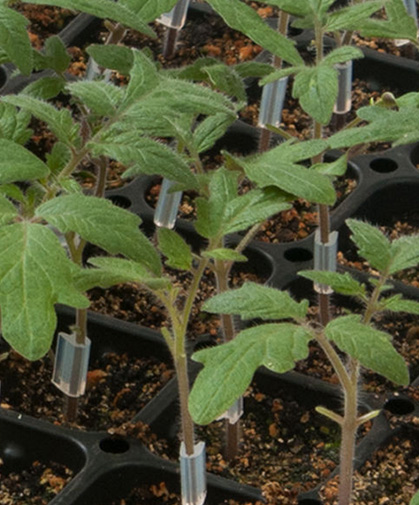- Video: 'Cherry Bomb' | JSS-Bred Organic Cherry x Grape Tomato from Johnny's
- Open-Pollinated Revival Project: 3 Improved OP Heirloom & Heritage Tomatoes
- 3 Ways to Choose the Best Tomato Varieties | Johnny's Selected Seeds
- Video: Tomato Pruning 101 • Tutorial with Niki Jabbour
- 'Unity' Red Beefsteak Tomato Variety from Johnny's
- Tomatoes: 10 Unsung Heroes | Johnny's Educational Webinar Resources
- Video: Tomatoes: 10 Unsung Heroes | Johnny's Webinar Series
- Video: High-Value Crops & Varieties for Your Garden • Tutorial with Niki Jabbour
- 10 Tips for Growing Heirloom Tomatoes
- Fundamentals of Tomato Grafting | Johnny's Educational Webinar Resources
- Video: How to Prune Greenhouse Tomatoes
- Video: How to Graft Greenhouse Tomatoes
- Video: Artisan Tomatoes™ | from Johnny's Selected Seeds
- Greenhouse Tomato Varieties | Comparison Chart (PDF)
- Video: How to Identify Late Blight on Tomatoes
- 'Honey Bee' and 'Queen Bee' Organic Cherry Tomatoes With Late Blight Resistance From Johnny's
- Tomato Innovation: Breeding & Trialing for Your Finest Harvest
- Video: Tomato Variety Trends: How Breeding Influences Your Seed Selection | Johnny's Webinar Series
- Top-Grafting Tomatoes | Advantages, Materials, Technique | Tech Sheet (PDF)
- 'Honey Bee' and 'Queen Bee' Organic Cherry Tomatoes With Late Blight Resistance From Johnny's
- Determinate Tomato Varieties | Comparison Chart (PDF)
- 'GinFiz' & 'Margold' Beefsteak Tomatoes for the Greenhouse
- Grafted Tomato Plants | Key Growing Information
- 'Maxifort' Rootstock Tomato Germination | Tech Sheet (PDF)
- Video: 'Clementine' | The Tangerine-Colored, Organic Cocktail Tomato from Johnny's Breeding Team
- Video: Growing Tomatoes in Containers with Niki Jabbour & Johnny's
- French Heritage Tomato Varieties | The Best of the Old World Marries the New
- Webinar Slide Deck | Fundamentals of Tomato Grafting | 15-pp PDF
- Grow a Rainbow Mix of Cherry Tomatoes
- Video: 'Mochi' : The Gumdrop-like Cherry Tomato | Exclusively from Johnny's
- Video: Choosing & Growing Paste Tomatoes for Sauce-Making • with Niki Jabbour
- Trellising & Crop Support Systems for Tomatoes | Stake & Basketweave, Stake & Hanging String/Wire, Lower & Lean
- Tomato Production Challenges & Issues | Tech Sheet (PDF)
- Greenhouse Tomatoes | Key Growing Information
- Video: How to Prune Tomatoes
- Greenhouse Tomato Pruning & String Trellising | Tech Sheet (PDF)
- Heirloom Tomato Varieties | Comparison Chart (PDF)
- Late-Summer Recipe Preview with Farmer-Chef Frank Giglio | Three Lily Farm, Thorndike, Maine
- Video: How to Grow Cherry Tomatoes • From Seed to Harvest
- Paste, Plum & Roma Tomato Varieties | Comparison Chart (PDF)
- Webinar Slide Deck | Tomato Variety Trends: How Breeding Influences Your Seed Selection | 29-pp PDF
- Video: An Intro to the Fundamentals of Tomato Grafting Success | Johnny's Webinar Series
- Side-Grafting Tomatoes | Advantages, Materials, Technique | Tech Sheet (PDF)
- Common Tomato Pests, Diseases & Physiological Disorders | An Overview of Biotic & Abiotic Problems
- 'Mimosa' — Organic Orange Grape Tomato Variety Developed By Johnny's
- Video: How We Process Our 'Washington Cherry' Tomato Seed
- Webinar Slide Deck | Tomatoes: 10 Unsung Heroes | 34-pp PDF
- Tomato Variety Trends: How Breeding Influences Your Seed Selection | Johnny's Educational Webinar Resources
- Rootstock Tomatoes | Key Growing Information
- Video: How to Manage Late Blight on Tomatoes (Phytophthora infestans)
- Video: 'Hot Streak' : The Vibrant New Striped Tomato | Exclusively from Johnny's
- Tomatoes | Key Growing Information
- Top-10 Field Tomatoes to Try in Your High Tunnel
- Video: Tomato Top-Grafting Demo: Splice Grafting & Cleft Grafting • Materials & Technique
- Tomato Innovation: Breeding & Trialing for Your Finest Harvest
- Basket-weave Trellising Instructions for Tomato & Pepper Plants | Tech Sheet (PDF)
Grafted Tomato Plants - Key Growing Information

INDETERMINATE: (climbing) varieties should be staked, trellised, or caged, and pruned for best results; fruit ripens over an extended period.
TRANSPLANTING OUTDOORS: Transplant into medium-rich garden or field soil 24-36" apart for indeterminate, unstaked varieties, and 14-20" for staking. Plant with the graft union above the soil line to prevent the top, scion variety coming into contact with the soil. Water seedlings with a high-phosphate fertilizer solution. For earliest crops, set plants out around the last frost date under floating row covers, which will protect from frost to about 28°F (-2°C). If possible, avoid setting out unprotected plants until night temperatures are over 45°F (7°C). Frost will cause severe damage.
FERTILIZER: Abundant soil phosphorus is important for early high yields. Too much nitrogen causes rampant growth and soft fruits susceptible to rot.
DISEASES: Learn the common tomato diseases in your area. Select resistant varieties. For prevention, use young, healthy transplants, avoid overhead irrigation, plow in tomato plant refuse in the fall, rotate crops, and do not handle tobacco or smoke before handling plants. Fungicides can reduce certain diseases when properly selected and applied.
BLOSSOM END ROT: Prevent blossom end rot by providing abundant soil calcium and an even supply of soil moisture.
INSECT PESTS: Use row covers to protect young seedlings from flea beetles. Tomato hornworms can be controlled with Bacillus thuringiensis. Use spinosad for potato beetle larvae and adults.
HARVEST: Fully vine-ripen fruit only for local retailing or use. To deliver sound fruit, pick fruit less ripe the further the distance and the longer the time between the field and the customer.
STORAGE: Store firm, ripe fruit 45-60°F (7-16°C) for 4-7 days.
DAYS TO MATURITY: From transplants.

